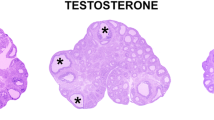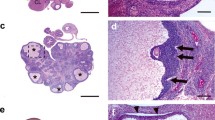Abstract
Exposure of the female sheep fetus to exogenous testosterone in early pregnancy permanently masculinizes the reproductive neuroendocrine axis. Specifically, in utero androgens given to female lambs from day 30 to 90 of a 147 day pregnancy dramatically altered the response of the gonadotropin releasing hormone (GnRH) neuronal network in the hypothalamus to both estrogen (E) and progesterone (P) feedback. Elevated concentrations of estrogen stimulated a massive release of GnRH in gonadectomized female sheep; however, male and androgenized female lambs were unable to respond to high E concentrations by producing this preovulatory-like “surge” of GnRH. Further, the inhibitory actions of progesterone (P) were also sexually differentiated and adult males and androgenized females were much less responsive to P-negative feedback than normal ewes. The consequences of these abnormal steroid feedback mechanisms were reflected in the fact that only 72% of ovary-intact androgenized ewes exhibited normal estrous cycles in their first breeding season whereas none had a single estrous cycle during the second breeding season. In contrast, 100% of the control animals exhibited repeated reproductive cycles in both seasons. These data indicate that a relatively short exposure to male hormones during in utero life permanently alters the neural mechanisms that control reproduction and leads progressively to a state of infertility.
Similar content being viewed by others
REFERENCES
Clarke, I. J., Scaramuzzi, R. J., & Short, R. V. (1976). Effects of testosterone implants in pregnant sheep on their female offspring. Journal of Embryology and Experimental Morphology, 36, 87-99.
Clarke, I. J., Scaramuzzi, R. J., & Short, R. V. (1977). Ovulation in prenatally androgenized ewes. Journal of Endocrinology, 73, 385-389.
Goodman, R. L. (1994). Neuroendocrine control of the ovine estrous cycle. In E. Knobil & J.D. Neill (Eds.), The physiology of reproduction (2nd ed.). New York: Raven Press.
Goodman, R. L., & Karsch, F. J. (1980). Pulsatile secretion of luteinizing hormone: Differential suppression by ovarian steroids. Endocrinology, 107, 1286-1290.
Goodman, R. L., Legan, S. L., Ryan, K. D., Foster, D. L., & Karsch, F. J. (1981). Importance of variations in behavioural and feedback actions of oestradiol to the control of seasonal breeding in the ewe. Journal of Endocrinology, 89, 229-240.
Gorski, R. A. (1968). Influence of age on the response to paranatal administration of a low dose of androgen. Endocrinology, 82, 1001-1004.
Gorski, R. A. (1985). Sexual differentiation of the brain: Possible mechanisms and implications. Canadian Journal of Physiology and Pharmacology, 63, 577-594.
Herkimer, C., West, C., Robinson, J. E., Foster, D. L., & Padmanabhan, V. (2000). Prenatal androgenization does not advance the timing of onset of ovarian cyclicity in female sheep. Paper presented at the meeting of the Society for the Study of Reproduction, Madison, WI.
Moenter, S. M., Caraty, A., & Karsch, F. J. (1990). The estradiol-induced surge of gonadotropin-releasing hormone in the ewe. Endocrinology, 127, 1375-1384.
Robinson, J. E., Forsdike, R. A., & Taylor, J. A. (1999). In utero exposure of female lambs to testosterone reduces the sensitivity of the gonadotropin-releasing hormone neuronal network to inhibition by progesterone. Endocrinology, 140, 5797-5805.
Short, R. V. (1974). Sexual differentiation of the brain of the sheep. INSERM, 32, 121-142.
Wood, R. I., & Foster, D.L. (1998). Sexual differentiation of reproductive neuroendocrine function in sheep. Reviews in Reproduction, 3, 130-140.
Wood, R. I., Robinson, J. E., Forsdike, R. A., Padmanabhan, V., & Foster, D. L. (2000). Sexual differentiation of the timing of sexual maturation in sheep. In J.-P. Bourguignon & T. M. Plant (Eds.), The onset of puberty in perspective (pp. 269-287). Amsterdam: Elseiver.
Author information
Authors and Affiliations
Rights and permissions
About this article
Cite this article
Robinson, J.E., Birch, R.A., Foster, D.L. et al. Prenatal Exposure of the Ovine Fetus to Androgens Sexually Differentiates the Steroid Feedback Mechanisms That Control Gonadotropin Releasing Hormone Secretion and Disrupts Ovarian Cycles. Arch Sex Behav 31, 35–41 (2002). https://doi.org/10.1023/A:1014075016956
Issue Date:
DOI: https://doi.org/10.1023/A:1014075016956




